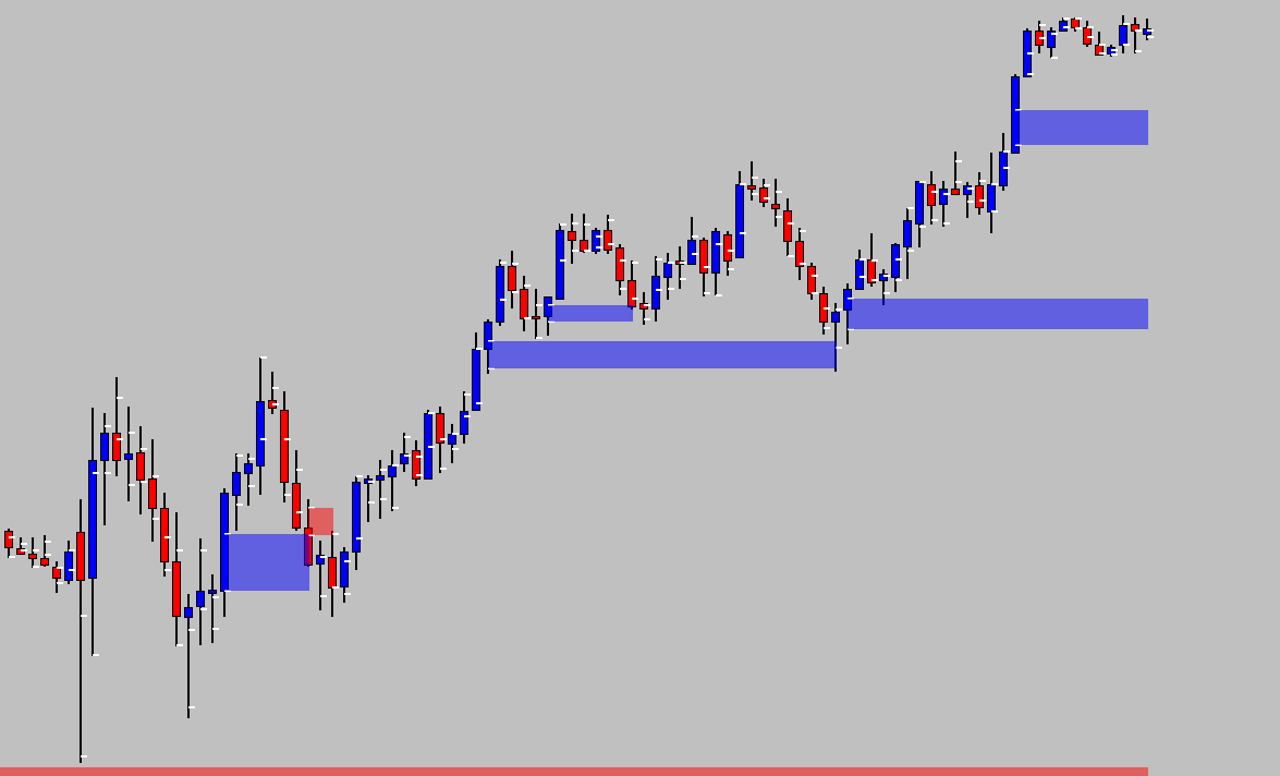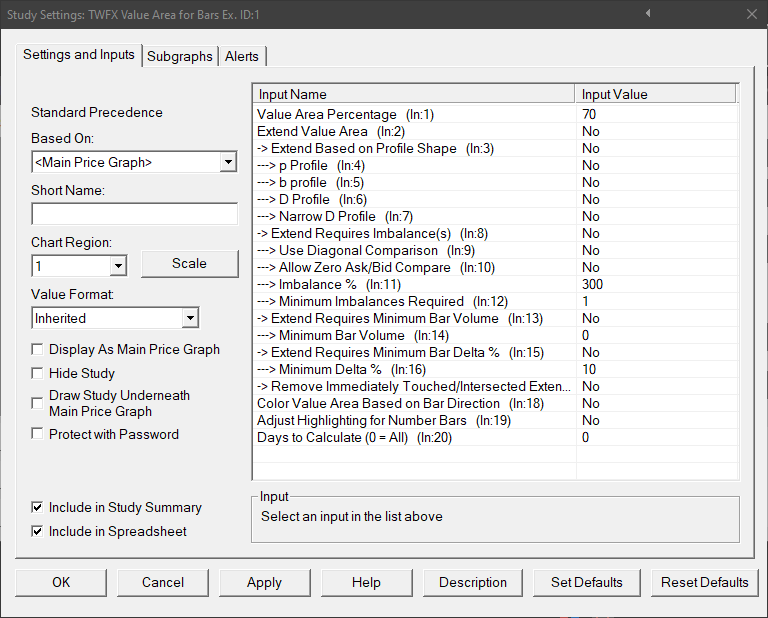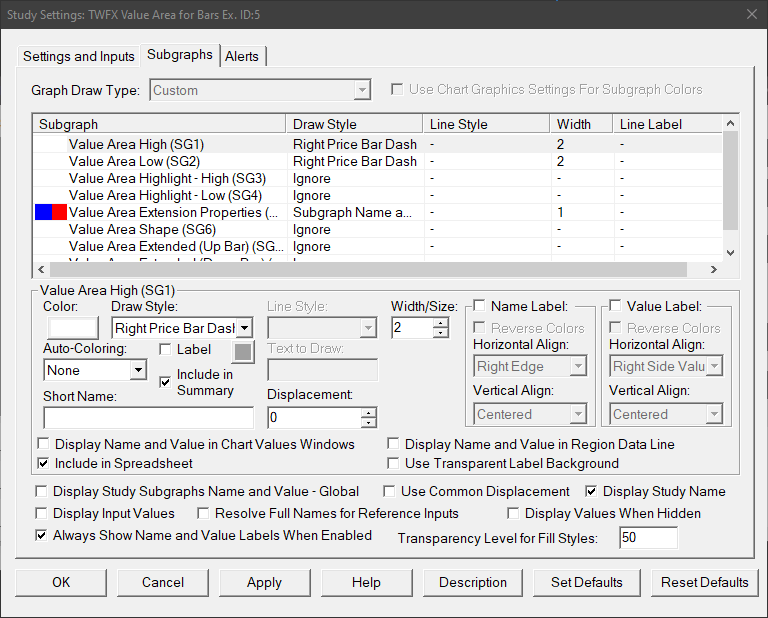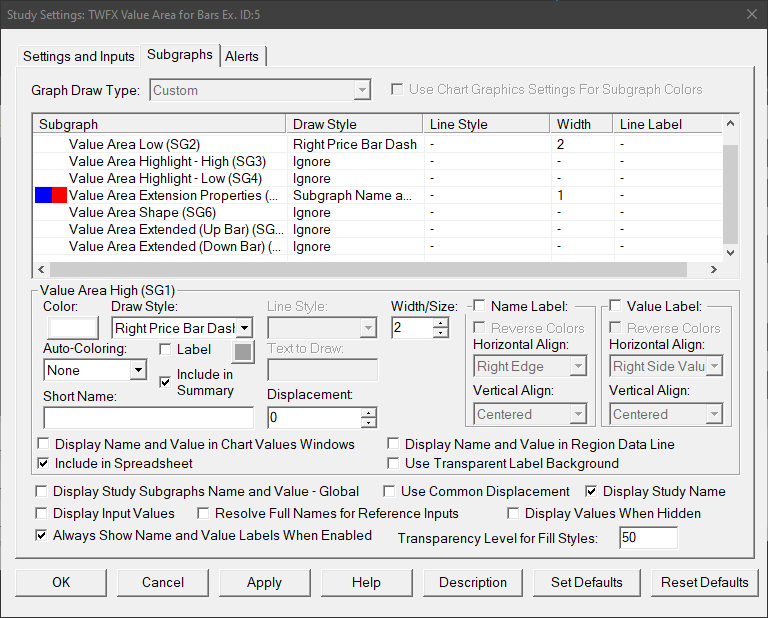The Value Area of Bars Ex Study highlights the value area for each chart bar, based on the user defined value area percentage. The value area can be extended into the future until intersected by price and/or colored according to bar direction, options are also provided to filter the displaying of value area extensions based on: Value distribution shape; per price ask/bid volume imbalances; bar volume; and delta as a percentage of volume.
Note:
- This study can only be used on charts with a chart data type of ‘Intraday Chart‘
- It is recommended to use ‘Intraday Data Storage Time Unit‘ setting ‘1 Tick’
Inputs
Value Area Percentage (In:1)
Defines the volume percentage taken to constitute the value area.
- Min: 50%
- Max: 100%
Extend Value Area (In:2)
When enabled (and depending on the filtering criteria), the value area highlighting is extended into the future, until intersected by price. The appearance of value area highlighting is controlled via the ‘Value Area Extension Properties Subgraph’.
Extend Based on Profile Shape (In:3)
For the purposes of this study volume profiles shape are defined as follows :
- p Profile:
- Value area low within upper 50% of chart bar
- Value area high within upper 20% of chart bar
- Volume at price for all prices outside of value area less than 0.5 * VPOC volume
- b Profile:
- Value area low within lower 20% of chart bar
- Value area high within lower 50% of chart bar
- Volume at price for all prices outside of value area less than 0.5 * VPOC volume
- D Profile:
- Value area low higher than lower 20% of chart bar
- Value area high lower than upper 20% of chart bar
- Value area high to low at least 50% of chart bar range
- Volume at price for all prices outside of value area less than 0.5 * VPOC volume
- Narrow D Profile:
- Value area low higher than lower 25% of chart bar
- Value area high lower than upper 25% of chart bar
- Value area high to low no greater than 33% of chart bar range
- Volume at price for all prices outside of value area less than 0.5 * VPOC volume
NOTE: If ‘Extend Based on Profile Shape’ is enabled and the chart bar range is 5 ticks or less, no value area extension is drawn regardless of the apparent shape of the profile.
p Profile (In:4)
Value area extensions are drawn for profile shapes meeting the ‘p Profile‘ criteria.
b Profile (In:5)
Value area extensions are drawn for profile shapes meeting the ‘b Profile‘ criteria.
D Profile (In:6)
Value area extensions are drawn for profile shapes meeting the ‘D Profile‘ criteria.
Narrow D Profile (In:7)
Value area extensions are drawn for profile shapes meeting the ‘Narrow D Profile‘ criteria.
Extend Requires Imbalance(s) (In:8)
Value area extensions are drawn only for chart bars containing the minimum number of ask/bid volume imbalances meeting the defined criteria.
Use Diagonal Comparison (In:9)
Defines the compare method used when determining ask/bid volume imbalances.
- Yes: Bid volume is compared against Ask volume at the next highest price level
- No: Bid volume is compared against Ask volume at the same price level
Allow Zero Ask/Bid Compare (In:10)
Defines the action taken when comparing ask or bid volume against a level with no volume on the opposite side.
- Yes: When calculating the volume imbalance, and the opposite side is zero, 1 is used instead.
- No: No comparison is made when the opposite side volume is zero.
Imbalance % (In:11)
Defines the minimum volume imbalance required for the price level to count towards the total number of imbalances.
Imbalance % is defined as the side (ask or bid) with the largest volume as a percentage of the side with the smallest volume.
- Min: 101
- Max: 1000
Minimum Imbalances Required (In:12)
Defines the minimum number of imbalanced price levels required for a value area extension to be drawn.
- Min: 1
- Max: 20
Extend Requires Minimum Bar Volume (In:13)
Value area extensions are drawn only for chart bars where the total volume is greater than or equal to the ‘Minimum Bar Volume’ threshold.
Minimum Bar Volume (In:14)
Defines the minimum bar volume threshold.
- Min: 0
- Max: 1000000
Extend Requires Minimum Bar Delta % (In:15)
Value area extensions are drawn only for chart bars where the bar delta (expressed as a percentage of the total volume) is greater than or equal to the ‘Minimum Delta %’ threshold.
Minimum Delta % (In:16)
Defines the minimum bar delta % threshold.
- Min: 1
- Max: 100
Remove Immediately Touched/Intersected Extensions (In:17)
Value area extension highlighting is removed for a chart bar if the value is touched or intersected by the next chart bar.
Color Value Area Based on Bar Direction (In:18)
Bar value area highlighting is colored based on the current bar direction and using the colors set via the ‘Value Area Extension Properties Subgraph’, up bar value areas being colored using the primary color and down bar value areas being colored using the secondary color.
NOTE:
This setting does not apply to value area extension, only to per bar value area highlighting (‘Value Area Highlight – High’ and ‘Value Area Highlight – Low’ subgraphs)
If the bar direction cannot be determined from the current chart bar alone, then:
- The bar direction will be determined by the most recent chart bar from the previous, where it is possible to determine the bar direction; or
- If it is not possible to determine the bar direction from the previous three charts bars, then the bar will be considered an up bar.
Adjust Highlighting for Number Bars (In:19)
To prevent the value area highlighting obscuring values displayed when using the number bars study, the value area high and low are adjusted by half of one tick up and down respectively.
Days to Calculate (In:20)
Defines the number of days over which the study is calculated, can be used to reduce the initial study calculation time when many days worth of data is loaded into the chart but this study is only required to be shown on the most recent days.
- Min: 0 (in which case all loaded bars are evaluated during the study calculation)
- Max: 1000000
Subgraphs
Value Area High (SG1)
Default: Dash
Displays a line at the value area high for each chart bar.
Value Area Low (SG2)
Default: Dash
Displays a line at the value area low for each chart bar.
Value Area Highlight – High (SG3)
Default: Transparent Fill Rectangle Top
Value Area Highlight – Low (SG4)
Default: Transparent Fill Rectangle Bottom
‘Value Area Highlight – High’ and ‘Value Area Highlight – Low’ subgraphs are used together to draw the value area highlighting for each chart bar, for more information refer to the following link: Top and Bottoms Drawstyles
Value Area Extension Properties (SG5)
Default: Subgraph Name and Value Labels Only
Determine the colors used for value area extensions.
Up bar value area extensions use the primary color, whereas down bar value area extension use the secondary color.
NOTE:
The ‘Transparency Level for Fill Styles’ setting also controls the transparency level used for value area extensions.
Value Area Shape (SG6)
Default: Ignore
Stores values representing the profile shape when ‘Extend Bases on Profile Shape’ is enabled.
- 1 = ‘p’
- 2 = ‘b’
- 3 = ‘D’
- 4 = ‘narrow D’
Value Area Extended (Up Bar) (SG7)
Default: Ignore
Stores value 1 when up bar value area extension is drawn, otherwise 0.
Value Area Extended (Down Bar) (SG8)
Default: Ignore
Stores value 1 when down bar value area extension is drawn, otherwise 0.




